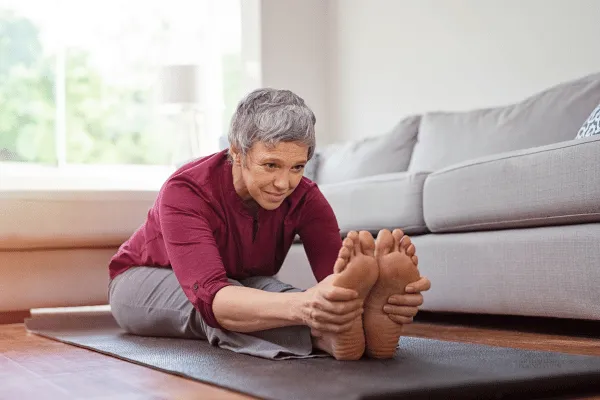Your Guide to Understanding Psoriatic Arthritis
Psoriatic arthritis (PsA) is a condition where our body's immune system mistakenly targets healthy cells, often appearing alongside psoriasis. Beyond skin symptoms, it can impact our joints, internal organs, and even our eyes. It's worth noting that its signs can resemble other conditions, so pinpointing a diagnosis can be a bit of a puzzle.
Navigating life with PsA is a unique journey for everyone. Whether you're new to the diagnosis or have been managing it for some time, having the right information and support is invaluable. Dive into our site for insights on PsA, from understanding the diagnosis to exploring treatments. Alongside, discover tips for daily management, and avenues to advocate not just for yourself but for others too.

Why 70% of People with Rheumatic Diseases Aren’t Meeting Exercise Goals—And Why It Matters
Living with inflammatory rheumatic diseases (IRDs), like rheumatoid arthritis, often means battling fatigue, joint pain, and stiffness on a daily basis. But did you know that regular physical activity can help reduce fatigue and improve your overall well-being? Unfortunately, a recent study published in Rheumatology Advances in Practice found that nearly 70% of people with IRDs are not reaching recommended physical activity goals.
If you’re struggling to move more, you’re not alone—and this article will explain why physical activity matters, what the research says, and how small steps can make a big difference.
Researchers, led by Dr. Stuart R. Gray from the University of Glasgow, wanted to understand how physical activity impacts fatigue in people with IRDs. To do this, they analyzed data from 337 adults who wore thigh-worn accelerometers—small devices that track movement throughout the day.
The Key Findings:
68.4% of participants failed to meet the recommended 150 minutes of moderate-to-vigorous physical activity per week (or roughly 20 minutes a day).
Patients who did more physical activity overall and had higher step counts reported significantly lower levels of fatigue.
People who spent more time doing sustained, moderate-to-vigorous exercise (instead of only light activity) saw the greatest improvements in fatigue scores.
Fatigue is often one of the hardest symptoms for people with IRDs to manage. In fact, about 80% of patients experience significant fatigue, and 70% say it feels just as burdensome as pain. These findings highlight how regular movement can make a real difference.
Why Is Physical Activity So Important?
For people with rheumatic diseases, fatigue can feel like a heavy weight holding you back. It’s not just being tired—it’s an overwhelming exhaustion that makes even simple tasks difficult. But here’s the good news: exercise has been proven to reduce fatigue, improve energy levels, and strengthen your body to better handle daily activities.
Dr. Gray explains:
“This study, along with previous research, shows that we need to promote sensible, personalized activity programs to help people with IRDs move more without burning out.”
Regular movement, especially moderate-to-vigorous activity, can help you:
✅ Reduce Fatigue: Physical activity improves blood flow, boosts energy, and helps combat inflammation.
✅ Build Strength: Stronger muscles help support your joints, reducing pain and stiffness.
✅ Improve Overall Health: Exercise lowers your risk of heart disease, improves mood, and boosts your immune system.
Why Aren’t More People Exercising?
For many with inflammatory conditions, physical activity feels overwhelming. Pain, stiffness, and fatigue can make the idea of exercise seem impossible. On top of that, there’s often fear of overdoing it and making symptoms worse.
This is why personalized exercise plans are so important. Programs tailored to your specific needs can help you move safely, build confidence, and avoid burnout.
How to Start Moving—One Step at a Time
If you’ve been struggling to meet physical activity goals, don’t worry. The key is to start small and focus on progress, not perfection. Here are some tips to help you get started:
Take It Slow: Begin with gentle activities, like short walks or light stretches. Aim for just 5-10 minutes a day and build up gradually.
Focus on Consistency: Regular movement—even if it’s light—is better than doing too much all at once. Small efforts add up over time!
Try Different Activities: Not a fan of walking? That’s okay! Try swimming, cycling, yoga, or even chair-based exercises. Find what feels good for you.
Track Your Progress: Use a fitness tracker, pedometer, or app to monitor steps or activity levels. Setting small goals can help keep you motivated.
Talk to Your Doctor: Work with your healthcare provider to create a personalized exercise plan that fits your needs and helps you feel your best.
Exercise might feel like a challenge when you’re living with a condition like rheumatoid arthritis, but it’s one of the most effective tools for managing fatigue and improving your quality of life. Even if you start small—just a few minutes a day—you’ll begin to see benefits over time.
At the American Arthritis Foundation, we encourage everyone to take that first step toward better health. Whether it’s a short walk, a gentle stretch, or a few extra steps each day, every little bit counts.
Let’s work together to move more, feel better, and reclaim your energy! Want to be part of our 21-Day Joint Health and Lymphatic Flow Challenge? SIGNUP NOW!
Have a question?
We're Here to Help
By providing my phone number, I agree to receive text messages from the business.


